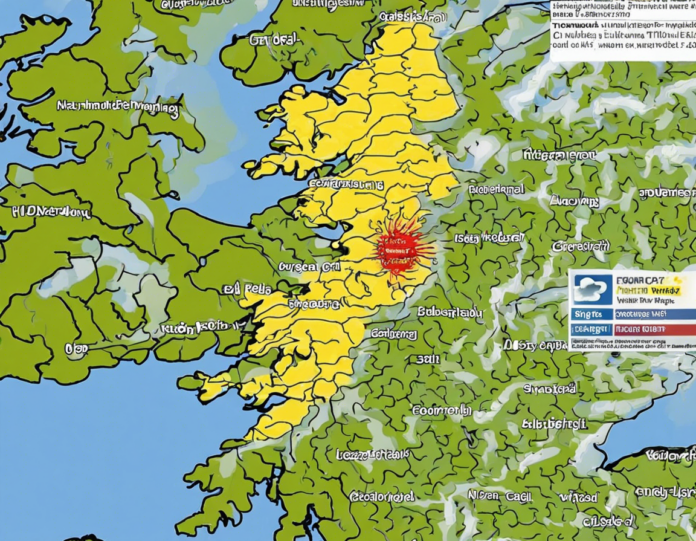Introduction
With the unpredictability of the British weather, it’s essential to stay updated and prepared. The UK is no stranger to thunderstorms, particularly during the summer months. The Met Office issues different types of weather warnings to alert the public about potential hazards. One such warning is the yellow weather warning, which signifies that adverse weather conditions are expected. In this article, we will delve into what a yellow weather warning entails, how to stay safe during thunderstorms, and other essential tips to weather the storm.
Understanding Yellow Weather Warnings
What is a Yellow Weather Warning?
A yellow weather warning is issued by the Met Office to warn the public about potentially hazardous weather conditions that may cause disruption to daily routines. In the case of thunderstorms, a yellow warning indicates that there is a possibility of heavy rainfall, lightning strikes, strong winds, and even hail. It serves as an alert for people to be cautious and prepared for adverse weather conditions.
Criteria for Issuing a Yellow Weather Warning
The Met Office issues yellow weather warnings based on criteria such as the expected impact of the weather, the likelihood of the weather occurring, and the timing of the weather event. When these factors meet certain thresholds, a yellow weather warning is issued to notify the public to take necessary precautions.
Staying Safe During Thunderstorms
1. Stay Indoors
When a yellow weather warning for thunderstorms is in place, it’s crucial to stay indoors whenever possible. Seek shelter in a sturdy building to protect yourself from lightning strikes and heavy rainfall.
2. Avoid Electrical Appliances
During a thunderstorm, it’s advisable to avoid using electrical appliances to reduce the risk of electrical surges caused by lightning strikes. Unplug sensitive equipment and stay away from corded devices.
3. Be Mindful of Flooding
Heavy rainfall during thunderstorms can lead to flash floods. Be cautious of low-lying areas and avoid driving through flooded roads. If flooding occurs, move to higher ground and seek assistance if needed.
4. Keep Informed
Stay updated with the latest weather forecasts and warnings by tuning into weather reports on TV, radio, or online platforms. Being informed can help you make informed decisions and stay safe during severe weather events.
Preparing for a Thunderstorm
1. Emergency Kit
Prepare an emergency kit that includes essential items such as a flashlight, batteries, non-perishable food, water, first aid supplies, and important documents. This kit can be invaluable during power outages or emergency situations.
2. Secure Outdoor Items
Ensure that outdoor furniture, potted plants, and other loose items are secured or brought indoors before the thunderstorm hits. Strong winds during thunderstorms can easily turn these items into projectiles, causing damage to property and posing safety risks.
3. Check Your Roof
Inspect your roof for any loose or damaged tiles that could be dislodged by strong winds. Securing your roof can prevent water damage and potential leaks during heavy rainfall.
4. Trim Trees and Branches
Trim any overhanging branches or trees near your property that could be a potential hazard during a thunderstorm. Falling branches can cause damage to structures and pose a risk to individuals.
Frequently Asked Questions (FAQs)
1. What should I do if I am outdoors during a thunderstorm?
If you are outdoors during a thunderstorm, seek shelter in a sturdy building or a hard-topped vehicle. Avoid open areas, tall trees, and metal objects that can attract lightning.
2. Can thunderstorms cause power outages?
Yes, thunderstorms can lead to power outages due to lightning strikes, strong winds, and fallen trees damaging power lines. It’s essential to be prepared with alternative lighting sources and provisions in case of power disruptions.
3. How can I protect my electronic devices during a thunderstorm?
To protect electronic devices during a thunderstorm, unplug them from electrical outlets to prevent damage from power surges caused by lightning strikes. Using surge protectors can also help safeguard sensitive equipment.
4. Is it safe to use water during a thunderstorm?
Avoid using water during a thunderstorm, especially if lightning is present. Water is a conductor of electricity, and using appliances such as showers or faucets can pose a risk of electric shock during a thunderstorm.
5. How long do thunderstorms typically last in the UK?
Thunderstorms in the UK can vary in duration, lasting anywhere from a few minutes to several hours. The intensity and speed of thunderstorms can influence their duration, making it essential to stay informed about weather updates.
In conclusion, being prepared and informed is key to staying safe during thunderstorms, especially when a yellow weather warning is in effect. By following safety tips, preparing for emergencies, and staying vigilant during adverse weather conditions, you can protect yourself and your loved ones from the potential hazards of thunderstorms. Stay safe, stay informed, and weather the storm with caution and preparedness.








